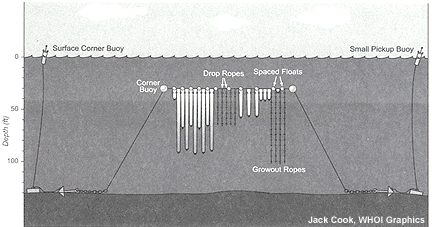
|
Archives:
Spring / Summer 1999 Table
of Contents
Before lending money to start-up businesses, lending institutions require borrowers to submit a business plan. A sound business plan considers–and accounts for–risks involved with a particular business venture. Imagine trying to develop a business plan for an offshore marine aquaculture operation, where many of the risks involved are unknown. That is precisely what policy analysts Porter Hoagland, Hauke Kite-Powell, Di Jin and their colleagues at the Woods Hole Oceanographic Institution (WHOI) Marine Policy Center are attempting to do. By applying financial business planning techniques with risk assessment techniques, they hope to better understand the viability of prospective offshore marine aquaculture operations in New England. Initially, they are developing bioeconomic feasibility models for grow-out operations of blue mussels and sea scallops, with plans for finfish (summer flounder, cod, and haddock) in the works.
"The operations of different types of farms include costs and details associated with running the farms," explains Hoagland, a research associate. "Some people call this the ‘economics’ of aquaculture, but it is really just a method of business accounting." "While the economics of nearshore operations have been well studied," explains Hoagland, "it’s really only within the last five to 10 years that entrepreneurs have begun to look at operating aquaculture facilities in offshore waters. "With nearshore operations, other users are the biggest problem," says Hoagland, referring to the conflicts that can erupt between fishers, shellfishers, homeowners, recreational users, and others. "In an offshore situation, you are moving away from those conflicts, but there are others to consider: higher transportation costs to and from a site, biological uncertainties about spawning and grow-out, and interactions with fishing boats and gear." To develop the models, researchers consider, individually, everything that could go wrong–and the likelihood that it would–and quantify that likelihood by assigning a numerical value or range of values. These values are factored into a model to determine loss. The model will be used to estimate the economic feasibility of one operation at one location and determine the minimum efficient scale of operations. In other words, at what level of production can the venture be considered profitable? "We have a good feeling for the major categories of risk," he says, "but we will be able to develop better quantitative estimates of risk once entrepreneurs get out there and start doing it." Right now, the group has access to two scenarios from which they can gather data. One is an offshore facility growing blue mussels in Rhode Island Sound; the other is an experimental sea scallop farm located off Martha’s Vineyard. Obtaining the necessary permits for the site took several months and substantial effort. "There really aren’t any ‘rules’ yet specific to offshore aquaculture," explains Hoagland. As such, the authority for permitting is now divided between several agencies: Army Corps of Engineers, National Marine Fisheries Service (NMFS), New England Fisheries Management Council, Environmental Protection Agency (EPA), and the U.S. Coast Guard. From a market perspective–the other main component of this study–issues affecting supply and demand become critical. The market for blue mussels varies widely by country. The European market for blue mussels is roughly $1 billion per year. And, while the U.S. market is growing, its value is only between $10 million and $11 million. Timing plays a key role: the peak market, and therefore optimal harvest time, is July through September. Though some risk factors still need to be worked into the model, preliminary data suggest that an offshore blue mussel aquaculture operation would become profitable if the market could yield $.54 per pound. To put this figure in perspective, Canadian cultured blue mussels now bring in approximately $.92 per pound. In terms of the scale of the operation, Hoagland believes that an ideal scenario would require "one boat for one year, operating to fullest capacity, with 300 long lines." He acknowledges that "a smaller scale operation would probably be feasible if the boat was rented or if boat time was purchased on a day-to-day basis," given the significant costs associated with owning and maintaining a boat. While blue mussels require the longline array for growout, sea scallops can be seeded directly on the seafloor. Cages, the alternative method for sea scallop growout, have a lower risk of loss, but a higher cost. This higher cost, says Hoagland, "greatly outweighs the lower probability of mortality in the cages." Under baseline assumptions–one being a loss of 50 percent–Hoagland and his colleagues concluded that "the only profitable alternative is seabed seeding."
Like most species, the market for sea scallops varies by season. Historically, December prices are highest for sea scallops, in part due to lower supply and higher demand around the holidays. This poses an inventory challenge for growers. Essentially, the sea scallops would have to be "held" fresh–that is, not harvested–until the price is optimal. Using the experimental project as a test for their model, Hoagland reports that an offshore operation yielding 100,000 pounds of scallops per cycle could be "marginally profitable at loss rates as high as 50 percent with a $4 per pound market price." If the market price was $6 per pound, he says, the operation could tolerate losses of nearly 70 percent and still be profitable. On average, New Bedford sea scallop prices fall within that range. "The trick [to offshore aquaculture]," says Hoagland, "is getting a handle on the risks involved, including those associated with the regulatory environment. Other states, like Connecticut and Maine, are more streamlined. However," he adds, "there is a lot of interest in just what a system to deal with offshore access might look like." Hoagland and his colleagues hope that may be just the motivation necessary to get things moving.
|

